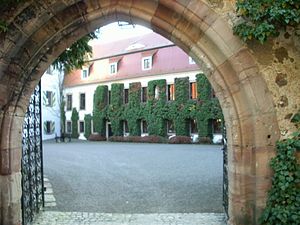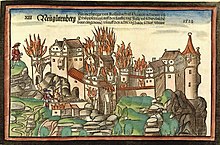Guttenberg Castle (Upper Franconia)
| Neuguttenberg Castle | ||
|---|---|---|
|
View of the main building of the castle |
||
| Alternative name (s): | Guttenberg Castle | |
| Creation time : | Neuguttenberg: 1482–1492
Altguttenberg: around 1318 |
|
| Castle type : | Location | |
| Conservation status: | Neuguttenberg: Today's facility does not show any features of the medieval castle
Altguttenberg: ruin in ruins, no remains recognizable |
|
| Standing position : | Aristocratic rule | |
| Place: | Guttenberg | |
| Geographical location | 50 ° 9 '7 " N , 11 ° 33' 57.5" E | |
| Height: | 560 m | |
|
|
||
The Neuguttenberg Castle and its predecessors castle old and Neuguttenberg are castles in the municipality Guttenberg (Upper Franconia) .
Origin and medieval history of the castle
The name is said to come from the personal name Cotto, an administrative officer of the Count Andechs , dukes of Merania. A Gundeloh von Plassenberg documented in 1148 , also a ministerial of the Counts of Andechs-Meranien, resident on the Plassenburg near Kulmbach , is considered the first in the line of the imperial knights, since 1700 Freiherr von Guttenberg, at Guttenberg Castle.
In the early 14th century the Guttenberg , a knightly knight dynasty of the lower nobility in the Upper Franconian region, tried to expand their fiefdom to Untersteinach , a place that was an important traffic junction with customs law and corresponding income at that time. In 1315, when Guttenberg Castle was taken over, the name changed from Plassenberg to von Guttenberg. They owned a small village of the same name with farmers who were subservient and compulsory labor . The expansion of the Altguttenberg castle complex is also dated to this period, for which the feudal givers, the bishops of the Bamberg diocese and then the margraves of Kulmbach , had the right to open it until 1342 . The builder of Altguttenberg Castle is Heinrich von Plassenberg, known as von Guttenberg, who combined the family's scattered property. With him the family line of those of Guttenberg began. In the Guttenberg feud , Altguttenberg Castle was besieged by Margrave Friedrich V of Brandenburg and at the end of the conflict it had to be handed over to him as the next fief.
Events in 1523
In the middle of the 16th century, the robber baron Hans Thomas von Absberg kidnapped merchants from imperial cities in Franconia , Swabia and the Egerland in the former Nordgau (Bavaria) on their trade trips, demanded a large ransom for their release and stole the trade goods. He had allies who supported him in his raids and hid him in their castles if there was a risk of capture. The gentlemen von Guttenberg , fiefs of the Alt- and Neuguttenberg Castle, were also part of it, as they hoped to be able to replenish their dwindling income. 1523 sent Swabian League of trading cities, led by Steward Georg von Waldburg , a contingent of 1,672 horsemen and 10,535 Fußkämpfern out to 23 " prey nests equalize" the ground at 18th and 19th place, the castles of Guttenberg. On July 5th they reached and occupied the facility and cremated it on July 8th in order to prevent the return of those of Guttenberg and other robber barons resident there and to put an end to the robbery. A woodcut from 1523 shows a view of the destroyed castle complex in Guttenberg.
In most of the records on the origins of the Guttenberg castle complex, the location of the two castles is described in such a way that when Neuguttenberg Castle was built, part of the complex was built in the courtyard of Altguttenberg Castle. In 1482, this action led to disputes between the Guttenbergers and the at least twelve co-owners and fiefs of Altguttenberg Castle, whose names are not known. In 1490 Altguttenberg was occupied by the Margrave Siegmund of Brandenburg-Kulmbach because the construction of Neuguttenberg Castle seemed threatening to him. Since Philipp von Guttenberg had his property occupied beforehand by one of the other ministerials, the knight Georg von Bayern, the margrave expropriated the Guttenbergers, who only got their property back around 1503. In contrast to Neuguttenberg, the older complex was not rebuilt after 1523 and fell into disrepair.
The woodcut by Hans Wandereisen
Main article: Wandereisen woodcuts from 1523
The Altguttenberg complex, which is relatively small compared to Neuguttenberg, dominates the larger Neuguttenberg Castle on the woodcut by Hans Wandereisen . Located on a flat hill, the castle is framed by rock formations. The complex consists of a palace , a gatehouse , a bretèche on the left side and an already devastated keep. The house on the right edge apparently did not belong to the actual complex, as otherwise it would have been destroyed by the troops. (See also Sparneck Castle ). In the center of the picture, remains of the wall and beams can be seen that could have come from Neuguttenberg Castle. In this section, the federal troops consist of a captain and three senior officers on the right edge of the picture, two riders in the center and a delegation of foot servants in the left half of the picture.
In the woodcut by Hans Wandereisen, there are no other buildings besides Neuguttenberg Castle. The relatively large area is on a spur , on the top of the keep towers. Five of the castle's nine main buildings are already on fire when the troops of the Swabian League of Cities, shown here with four men, approach the castle. A tower in the middle of the castle is already being blown up, which can be recognized by the pointed flames.
The castle complex after it was destroyed in 1523
The Guttenberg castle complex was rebuilt after it was destroyed by the Swabian Association of Towns; further sieges in the following centuries did not leave its mark without a trace. After a fire in 1908, it was completely renovated. Only a few references to the medieval structure have been preserved.
Today Guttenberg Castle with inventory and forest operations is owned by the Freiherrlich von und zu Guttenberg private foundation in Radmer in Styria in Austria, which was founded by Philipp Franz zu Guttenberg . The castle was the residence of the former head of the house, Enoch zu Guttenberg , and his family from the second marriage, before he died in 2018.
literature
- Karl-Ludwig Lippert : Stadtsteinach district . The art monuments of Bavaria , brief inventories, XX. Band . German art publisher . Munich 1964. pp. 31-38.
- Karl Dietel in the Münchberg City Archives
- Burgenbuch der Staatsbibliothek Bamberg , Hienach stont Form vnd designed abbosses the 23 castles So the Swabian Bunndt has taken a Vnd in Yar 1523 The two month June and July Also the same name (s), on which (n) t yedes lay (n), vn (d) who has had it during the (er) time, also the vo (n) nobility so be versed to such a train by a mottled covenant . Handwritten title on the parchment binding : CONTRFECT ETLICHER KRIGSHANDLVNG FROM 1523 TO 1527. IAR. , Signature: RB.H.bell.f.1 - A total of 66 sheets, 23.5 × 30 cm.
Web links
Individual evidence
- ^ Eberhard Isenmann: The German city in the Middle Ages 1150–1550. City shape, law, constitution, city government, church, society, economy . 2nd Edition. Böhlau Verlag, Cologne 2014, ISBN 978-3-412-20940-7 , pp. 502 .







